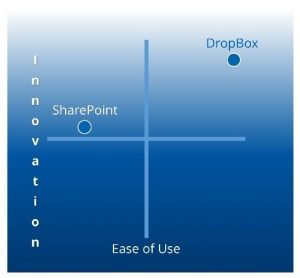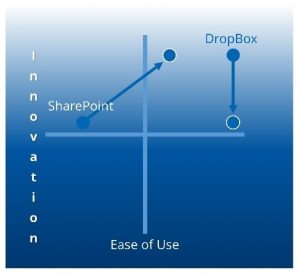What Software Companies Can Learn: Why We Switched from Dropbox to SharePoint
Background
A short while ago our company made the switch from Dropbox, a rock-solid file hosting service, to Microsoft’s SharePoint for our corporate file hosting and sharing service. If a product is rock-solid, why did we switch? (And, no, price had nothing to do with it.)
When we first adopted Dropbox, it was because our requirements for file management were simply i) it needed to be cloud-based, and ii) it needed to just work. Dropbox fit the bill.
As a firm that was standardized on the desktop version of Microsoft Office, SharePoint was an obvious choice. But our experience over the years with SharePoint was that it was very inconsistent with file syncing, the process of ensuring that the latest versions of files are both on your computer and in the cloud, ‘synced.’ With SharePoint, sometimes files would sync, and sometimes they wouldn’t, and you would end up with slightly different copies of the same file, with slightly different filenames. Very frustrating. It did not just work.
Dropbox came along, innovated in the file hosting space, and figured out how to make file hosting and sharing, just work. ‘Ease of use’ was fantastic, core capabilities just worked, and Dropbox became our standard for file hosting.

Requirements Evolve
That was it though. We never used Dropbox for anything else. But our needs evolved. As we grew as a firm, we started collaborating more and more on projects, and that meant wanting to work on the same desktop version of Office documents at the same time. With Dropbox we could not do this. We would need to save our files with names such Project1-Jack, Project 1-Jon, etc., then track the respective slides that changed, and then merge them into a master Project-1 document. We were now back to our initial problem with SharePoint, too many unnecessary, unshared files. Dropbox no longer met our requirements.
Killer Feature
Collaborating real-time, with desktop versions of Word, Excel, and PowerPoint, became our must-have requirement. We decided to take another look at SharePoint, using it for saving our shared desktop Office documents, and lo and behold, we discovered that it worked very well. SharePoint had upped its game, innovating to allow a project team to consistently work on the same Office documents at the same time. We joked that “slides now write themselves” as I could watch a project team member edit in real-time a slide in a document that I was already in. SharePoint now had the killer feature we needed, and we switched!

Lessons Learned
At Topline Strategy, we partner with innovative companies looking to consistently maintain their competitive edge by developing market strategies based on real-time market insights. Understanding how markets are evolving, requirements are changing, and synthesizing that data into actionable next steps, are key to maintaining a competitive edge and ultimately sustaining and growing your customer base. Resting on your laurels has consequences.
To learn more about our market strategy practice and how we can help your firm maintain a competitive edge, please contact us at info@toplinestrategy.com.

